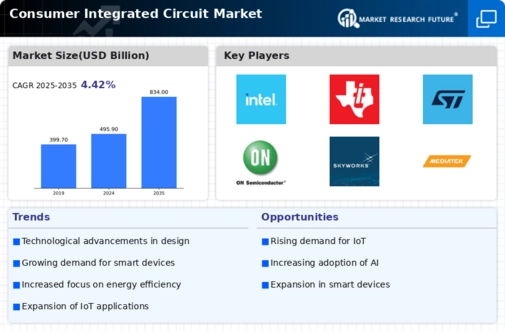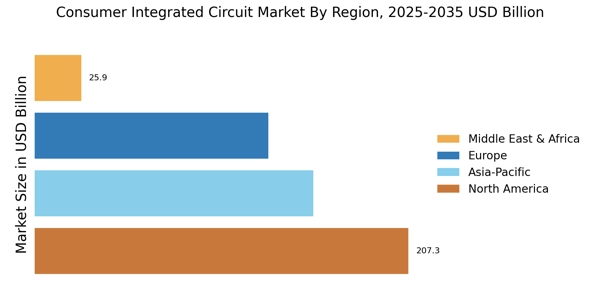Rise of 5G Technology
The rollout of 5G technology is poised to have a transformative impact on the Consumer Integrated Circuit Market. With its promise of faster data speeds and lower latency, 5G is expected to drive the development of new consumer electronics that leverage these capabilities. This technological advancement necessitates the creation of specialized integrated circuits designed to handle the demands of 5G connectivity. Market analysts predict that the 5G infrastructure will require a significant increase in the production of integrated circuits, particularly those that support high-frequency operations. As consumers increasingly adopt 5G-enabled devices, the Consumer Integrated Circuit Market is likely to experience robust growth, driven by the need for innovative solutions that can capitalize on the advantages of next-generation connectivity.
Advancements in IoT Technology
The proliferation of Internet of Things (IoT) technology is significantly influencing the Consumer Integrated Circuit Market. As more devices become interconnected, the need for efficient and compact integrated circuits has escalated. IoT applications, ranging from smart home devices to industrial automation, require specialized circuits that can handle data processing and communication effectively. Market analysis indicates that the IoT sector is expected to expand rapidly, with billions of devices anticipated to be connected in the coming years. This expansion necessitates the development of advanced integrated circuits tailored for IoT applications, thereby driving growth within the Consumer Integrated Circuit Market. The convergence of IoT and integrated circuits presents opportunities for innovation and enhanced functionality in consumer electronics.
Growing Focus on Sustainability
Sustainability has emerged as a pivotal concern within the Consumer Integrated Circuit Market. Manufacturers are increasingly prioritizing energy-efficient designs and environmentally friendly materials in their integrated circuits. This shift is largely driven by consumer demand for greener products and regulatory pressures aimed at reducing electronic waste. Recent studies suggest that energy-efficient integrated circuits can reduce power consumption by up to 30%, which is appealing to both consumers and manufacturers. As sustainability becomes a key differentiator in the market, companies that invest in eco-friendly technologies are likely to gain a competitive edge. This trend not only aligns with The Consumer Integrated Circuit Industry.
Emergence of Artificial Intelligence
The integration of artificial intelligence (AI) into consumer electronics is reshaping the Consumer Integrated Circuit Market. AI technologies require sophisticated processing capabilities, which in turn drives the demand for advanced integrated circuits. As devices become smarter and more capable of performing complex tasks, the need for high-performance circuits that can support AI functionalities is paramount. Market forecasts indicate that the AI semiconductor market is expected to witness substantial growth, with integrated circuits playing a crucial role in this evolution. The convergence of AI and consumer electronics not only enhances user experiences but also propels innovation within the Consumer Integrated Circuit Market, as manufacturers strive to meet the demands of increasingly intelligent devices.
Surge in Consumer Electronics Demand
The Consumer Integrated Circuit Market is experiencing a notable surge in demand for consumer electronics. This trend is primarily driven by the increasing adoption of smart devices, such as smartphones, tablets, and wearables. According to recent data, the consumer electronics sector is projected to grow at a compound annual growth rate of approximately 6% over the next few years. This growth is likely to propel the demand for integrated circuits, as these components are essential for the functionality of modern electronic devices. As consumers seek more advanced features and capabilities, manufacturers are compelled to innovate, thereby further stimulating the Consumer Integrated Circuit Market. The interplay between consumer preferences and technological advancements suggests a robust future for integrated circuits in the electronics landscape.

















Leave a Comment